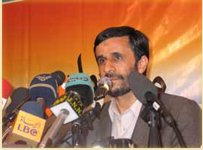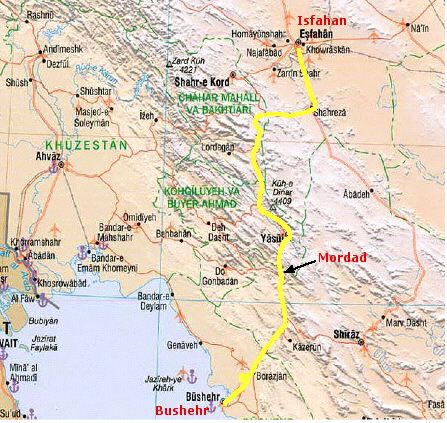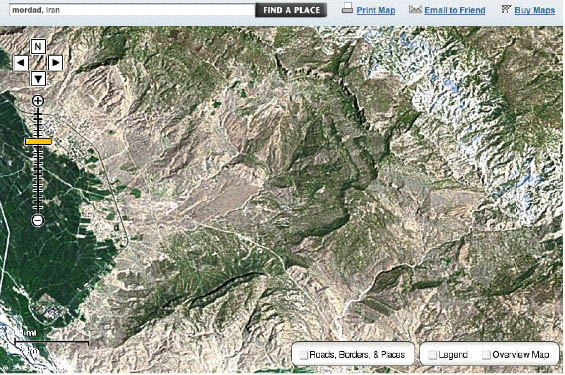THE OMINOUS CAVES OF MORDAD

On the first day of the Persian month of Mordad, a Zoroastrian member of the Iranian Parliament proposed renaming this fifth month of Iran's calendar. One of the few practitioners of a 3,000-year-old religion that predates Islam, Judaism and Christianity, this member of Parliament unsuccessfully sought to change the name of the month because of its ominous meaning.
Mordad means "death and nothingness." Another translation, on a Web site celebrating Persian culture and promoting tourism, renders the word more charitably as "immortality." Whatever the meaning, the Zoroastrian MP wanted to rename the month the much more cheerful "Amordad," or "life and eternity." Perhaps renaming the month was his way of trying to change the events unfolding in Iran.
(Incidentally, if we can get through the month of Mordad unscathed, it may be encouraging to note that the following month, beginning on the 23rd of August, is referred to as the month of "good choices" (Shahrivar), followed by the month of "friendship and trust" (Mehr). If Iran's President Ahmadinejad (seen in the photo above) made some "good choices," they probably would be followed by "trust and friendship.")
Mordad ends on the 22nd of August, a very auspicious day in several ways. Bernard Lewis, a professor at Princeton, recently wrote an op-ed piece in the Wall Street Journal about the significance of this day. He points out that this year, the 22nd of August coincides with the anniversary of the "night flight of Mohammed." Jack Kelly also pointed out the special religious significance of this Lailat al Miraj in his To The Point article of July 28, "Israel, Iran, and August 22."
The end of Mordad is also the deadline set by Iran's president Ahmadinejad for Iran's decision on nuclear enrichment. Thus in both the East and the West, the end of Mordad has practical and religious significance.
The word "Mordad" resembles English words of doom such as "mortal" and "more dead," and even "Mordor," the Black Land in The Lord of the Rings . But Mordad is more than just a Farsi word or the ominous-sounding name of a month. It is also a place in southwest Iran. A very interesting place.
Why would anyone name a place "Death," "Nothingness," or "Immortality"? Mordad, Iran, is not a terribly inhospitable place, like Death Valley, California. It is mountainous and sparsely populated, with what National Geographic classifies as "greenlands" nearby. There are farms a mile away, as revealed by satellite imagery. Thus it was not named Mordad for any reason of climate.
Its name may have a more disturbing origin. If you travel north from Bushehr directly to Isfahan, you go right past Mordad. This route between Isfahan and Bushehr is the link between two of Iran's most troubling nuclear facilities. Isfahan is said to be the primary location of the Iranian nuclear weapons program, home of a nuclear storage site, research reactors, and extensive nuclear laboratory facilities.

Bushehr, where large Russian nuclear reactors are under construction, is the subject of numerous international objections to Iran's nuclear program. These reactors could produce large quantities of fissionable material, used in nuclear weapons.
Mordad is about 1.5 miles off the main road, in a sparsely populated mountain enclave. Any trucks moving materials between Isfahan and Bushehr could easily take a little side trip to Mordad. Thanks to satellite photography, we can take a little trip to Mordad as well: http://plasma.nationalgeographic.com/mapmachine/index.html Put in Mordad, Iran, use Satellite tab, and reduce to the maximum magnification (which is within the city range).

If you look carefully, you can see some interesting structures.

Mordad appears to have one, possibly two or more very large caves in the side of a mountain, with a strong and resistant overlying layer providing roof support. Roads on the steep incline lead right up to the cave entrances. An apparent staging area below could handle very large vehicles.
Not only are there caves, there also is a flat prepared area resembling an airstrip about a half-mile long. What use would there be for an airstrip in the middle of nowhere? There appear to be other prepared areas, with what look like buildings in appropriate locations for guard buildings.
Consider this scenario: Nuclear materials preparation and bomb making could be going on in Mordad. Trucks could easily and surreptitiously deliver their loads to Mordad en route between other key nuclear facilities in Bushehr and Isfahan. Materials and equipment would be protected and hidden in the caves. Aircraft could land on the airstrip, pick up the nuclear bombs quickly from that secure location, and fly to their targets. Nuclear weapons would be exposed to American or Israeli air power for a minimum amount of time before use.
Would Iran be bold enough to actually name that facility what it is? Are they either that crazy or that confident? Consider that these people truly believe that the return of the 12th Imam is imminent and that their Armageddon plays a vital role in that prophecy. Jack Kelly wrote about the road that Ahmadinejad ordered to be fixed up because the Mahdi was expected to walk down it. The president of Iran makes no secret of his intentions or his religious fanaticism.
Ancient Persian mythology describes Mordad as one of the four Archangels, the one called the "Death Giver," according to British explorer Richard Burton's translation of The Arabian Nights . The Dictionary of Phrase and Fable refers to the "Angel of Death" in Mohammedan mythology; he is called Azarel by the Arabs and Mordad by the Persians. Thus if some zealous Persian Mohammedan like Ahmadinejad wanted a name for a nuclear device, no better name could exist than "Mordad."
Considering what it is and where it is and having that name , it is either an absurdly unlikely coincidence or the most suspicious nuclear site on Earth. Colin Powell has pointed out how impractical it would be to search all the caves in Iran. The caves of Mordad, however, are special: perfectly located, perfectly well equipped, and perfectly named after the Mohammedan Archangel of Death.
Given the strange behavior of Iran's president and that country's history, it would seem that Iran is far more menacing than what diplomats and the charming Ahmadinejad would have us believe. Mordad may be the place of our nuclear nightmare and the nuclear source of Ahmadinejad's religious aspirations. Something very dangerous may be lurking in the caves of Mordad.
Related links: http://www.payvand.com/news/06/jul/1237.html http://www.fallingrain.com/world/IR/7/Mordad.html http://cns.miis.edu/research/iran/images/mapbig.gif http://www.lib.utexas.edu/maps/middle_east_and_asia/iran_country_profile_2004.jpg http://www.persianmirror.com/culture/basics/basics.cfm#basic http://www.mehrnews.com/en/NewsDetail.aspx?NewsID=357618 http://groups.google.com/group/alt.quotations/browse_thread/ thread/87d3e1c59d03db58/12fd5312b9f24d74?lnk=st&q=&rnum=2#12fd5312b9f24d74 http://etext.library.adelaide.edu.au/b/burton/richard/b97b/afterword3.html http://en.wikipedia.org/wiki/Richard_Francis_Burton http://www.globalsecurity.org/wmd/world/iran/esfahan.htm http://www.globalsecurity.org/wmd/world/iran/bushehr.htm http://www.wisconsinproject.org/countries/iran/nuke2003.htm http://www.fwointl.com/download/P_F_Dictionary.pdf http://www.iranexpert.com/2004/us4december.htm http://tothepointnews.com/content/view/2379/130